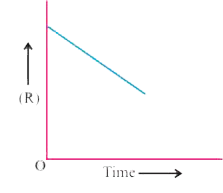For a two step reaction.
A⇔R+B R+Ck2−−→P
(where, R is a reactive intermediate whose concentration is maintained at some low steady state throughout the reaction). If the concentration of C is very high then the order of reaction for formation of "P" is
A
2
B
0
C
1
D
1/2
Text Solution
The correct Answer is:C
Rate law =dpdt=K2[R][C]
at steady state d[R]dt=0
d[R]dt=K1[A]−K2[R][B]−K2[R][C]=0
K1[A]={K2[B]+K2[C]}[R]
[R]=K1[A]K2{[B]+[C]}
Rate =K2×K1K2[A][B]+[C]×[C]
K1[A]–––––––
=[B][C]+1
where C is very high
Rate =K1[A]
∴ order of reaction=1 ]
|
Topper's Solved these Questions
- TEST PAPERSBOOK - BANSALCHAPTER - TEST PAPERSEXERCISE - CHEMISTRY SECTION - 2 [PARAGRAPH TYPE]
6 Videos
- TEST PAPERSBOOK - BANSALCHAPTER - TEST PAPERSEXERCISE - CHEMISTRY SECTION - 2 [MULTIPLE CORRECT CHOICE TYPE]
6 Videos
- TEST PAPERSBOOK - BANSALCHAPTER - TEST PAPERSEXERCISE - PHYSICS SECTION - 1 [MULTIPLE CORRECT CHOICE TYPE]
6 Videos
- PROBABILITYBOOK - BANSALCHAPTER - PROBABILITYEXERCISE - All Questions
1 Videos
- THERMODYNAMICSBOOK - BANSALCHAPTER - THERMODYNAMICSEXERCISE - Match the column
7 Videos
Similar Questions
Knowledge Check
For a two step reaction,
A⇔R+B R+Ck2−−→P
(Where , R is a reactive intermediate whose concentration is maintained at some low steady state throughout the reaction).If the concentration of C is very high then the order of reaction for formation of "P" is :A2B0C1D12For the reaction R→P when concentration of R is made double the rate of reaction becomes 2.828 times the order of reaction is
A2.5B1.5C1.0D2.0For the hypothetical reaction 2A→3C , the reaction rate r in terms of the rate of change of the concentration is given by
Ar=−d[A]dtBr=−12d[A]dtCr=13d[A]dtDr=d[A]dt
For a reaction R→P, half -life (t1/2) is observed to be independent of the initial concentration of reactants. What is the order of reaction ?
View SolutionThe concentration of R in the reaction R→P was measured as a function of time and the following data is obtained:

The order of the reaction is
View SolutionFor a reaction R→P, half -life (t1/2) is observed to be independent of the initial concentration of reactants. What is the order of reaction ?
View SolutionFor a reaction R→P, half -life (t1/2) is observed to be independent of the initial concentration of reactants. What is the order of reaction ?
View SolutionFor the hypothetical reaction 2 A → 3 C, give the reaction rate 'r' in terms of the rate of change of concentration of C.
View Solution

